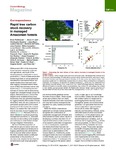Por favor, use este identificador para citar o enlazar este ítem:
http://www.alice.cnptia.embrapa.br/alice/handle/doc/1024777| Título: | Rapid tree carbon stock recovery in managed Amazonian forests. |
| Autor: | RUTISHAUSER, E.  HÉRAULT, B.   BARALOTO, C.   BLANC, L.   DESCROIX, L.   SOTTA, E. D.   FERREIRA, J.   KANASHIRO, M.   MAZZEI, L.   OLIVEIRA, M. V. N. d'   OLIVEIRA, L. C. de   PEÑA-CLAROS, M.   PUTZ, F. E.   RUSCHEL, A. R.   RODNEY, K.   ROOPSIND, A.   SHENKIN, A.   SILVA, K. E. da   SOUZA, C. R. de   TOLEDO, M.   VIDAL, E.   WEST, T. A. P.   WORTEL, V.   SIST, P.   |
| Afiliación: | Ervan Rutishauser, CarboForExpert / CIRAD; Bruno Hérault, CIRAD; Christopher Baraloto, INRA / Florida International University; Lilian Blanc, CIRAD; Laurent Descroix, ONF-Guyane; ELENEIDE DOFF SOTTA, CPAF-AP; JOICE NUNES FERREIRA, CPATU; MILTON KANASHIRO, CPATU; LUCAS JOSE MAZZEI DE FREITAS, CPATU; MARCUS VINICIO NEVES D OLIVEIRA, CPAF-AC; LUIS CLAUDIO DE OLIVEIRA, CPAF-AC; Marielos Peña-Claros, Forest Ecology and Forest Management Group / Instituto Boliviano de Investigación Forestal; Francis E. Putz, University of Florida; ADEMIR ROBERTO RUSCHEL, CPATU; Ken Rodney, Iwokrama; Anand Roopsind, University of Florida / Iwokrama; Alexander Shenkin, University of Oxford; KATIA EMIDIO DA SILVA, CPAA; CINTIA RODRIGUES DE SOUZA, CPAA; Marisol Toledo, Instituto Boliviano de Investigación Forestal; Edson Vidal, ESALQ/USP; Thales A. P. West, University of Florida; Verginia Wortel, CELOS; Plinio Sist, CIRAD. |
| Año: | 2015 |
| Referencia: | Current Biology, v. 25, n. 18, R787-R788, Sep. 2015. |
| Descripción: | While around 20% of the Amazonian forest has been cleared for pastures and agriculture, one fourth of the remaining forest is dedicated to wood production [1] . Most of these production forests have been or will be selectively harvested for commercial timber, but recent studies show that even soon after logging, harvested stands retain much of their tree-biomass carbon and biodiversity [2,3] . Comparing species richness of various animal taxa among logged and unlogged forests across the tropics, Burivalova et al.[4] found that despite some variability among taxa, biodiversity loss was generally explained by logging intensity (the number of trees extracted). Here, we use a network of 79 permanent sample plots (376 ha total) located at 10 sites across the Amazon Basin [5] to assess the main drivers of time-to-recovery of post-logging tree carbon ( Table S1 ). Recovery time is of direct relevance to policies governing management practices (i.e., allowable volumes cut and cutting cycle lengths), and indirectly to forest-based climate change mitigation interventions. |
| Thesagro: | Floresta |
| Palabras clave: | Estoque de carbono |
| DOI: | http://dx.doi.org/10.1016/j.cub.2015.07.034 |
| Tipo de Material: | Artigo de periódico |
| Acceso: | openAccess |
| Aparece en las colecciones: | Artigo em periódico indexado (CPAF-AP)  |
Ficheros en este ítem:
| Fichero | Descripción | Tamaño | Formato | |
|---|---|---|---|---|
| CPAFAP2015Rapidtreecarbonstock.pdf | 549,81 kB | Adobe PDF |  Visualizar/Abrir |









